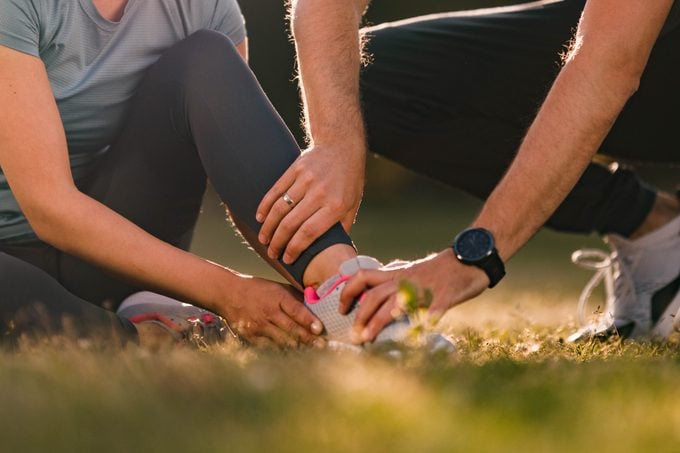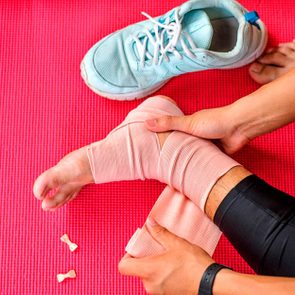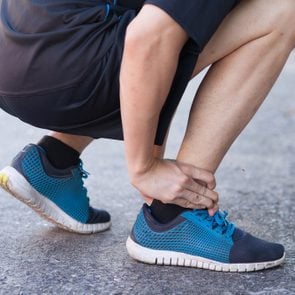How to Tell the Difference Between a Sprain and a Strain
Updated: Jun. 02, 2021
Sprains and strains both involve damage to soft body tissue. Here's how to recognize the difference, plus how to ease your pain.
Sprain vs. strain
You’ve tripped and hurt your ankle: ouch! It’s swollen, throbbing…clearly a sprain. Or, wait, is it a strain? What’s the difference?
If you’re confused and are constantly mixing a sprain vs. strain, you’re not alone.
“Sprains and strains can be easily mistaken for one another as they both refer to when the soft tissue that surrounds the joints is stretched too far—sometimes to the point of tearing,” says Gbolahan Okubadejo, MD, a spinal and orthopedic surgeon in New York City.
While the two might seem similar, there are nuanced differences between strains and sprains that require slightly different treatment: whether from your doctor or osteopath or through at-home treatment yourself.
We spoke with doctors and experts to find out the crucial differences between sprain vs. strains: everything from what they are, to how to treat them, to how to prevent them from happening again.
(These are nine common foot problems and the simple solutions from podiatrists.)
What’s a strain?
Strains refer to injuries to muscles and tendons, says Dr. Okubadejo says. “A strain is when muscles or tendons, which attach muscles to a bone, become overstretched or torn.”
If the muscle is overstretched, as can happen with vigorous exercise or when not properly warming up before a workout, it can tear, resulting in a strain.
Similarly, tendons—the cords of tissue connecting muscles to bones—can also stretch or tear.
A muscle strain is also known as a pulled muscle, says Marvin Singh, MD, owner of Precisione Clinic in San Diego. “It happens when a muscle is overused, improperly used, or overstretched and involves the muscles or tendons.”
Strains can occur in various areas of the body, but they’re most common in the lower back and the hamstring muscle in the back of the leg.
(Here’s how everyday moves can hurt your body.)
What’s a sprain?
Ever stepped off a curb, rolled your ankle, and landed the wrong way? You may have experienced a sprain.
“A sprain occurs when ligaments—the tissue that attaches bones together—become overstretched or torn,” explains Dr. Okubadejo.
This can happen in the ankle, knee, or wrist, but even your thumb or back can suffer a sprain. Regardless of the joint, when your ligaments twist, tear, or stretch beyond their capacity, you’re dealing with a sprain.
And while both sprains and strains can lead to pain and swelling, sprains can cause blood vessels to burst and trigger bruising.
Sprain vs. strain symptoms
With both injuries, you’ll experience pain, swelling, and some redness. But there are some key differences, says Dr. Okubadejo. “Usually with sprains, the area around the joint bruises.”
With a strain, on the other hand, you might get cramping, Dr. Singh explains. “Symptoms of both a strain and sprain may be similar. One of the biggest differences is that with a strain you may experience muscle spasms around the actual muscle that was involved.”
(Here how to prevent sports injuries and stay in the game.)

How do doctors diagnose a strain or a sprain?
You might be tempted to walk off the injury or wait it out to see if it feels better. For less serious injuries, Dr. Okubadejo believes people can treat themselves. Mild strains tend to repair themselves in around two to four weeks, he says, though if you’re in severe pain or you don’t feel much better after a few days, it’s time to see a doctor.
“Typically, sprains and strains need to be diagnosed by a medical professional,” says Dr. Okubadejo. “They’ll perform a brief physical exam and possibly an X-ray or an MRI.”
“Pain and tenderness is usually associated with a sprain or strain along with swelling and limited range of motion. Sometimes a person may hear a ‘pop,’ and that is a telltale sign of the tearing of a ligament leading to a sprain,” he explains.
Your doctor will typically diagnose a strain or sprain by obtaining your history and through a physical examination, says Tomas Pevny, MD, an orthopedic surgeon with ValleyOrtho in Glenwood Springs, Colorado. “If there is any uncertainty, imaging is helpful: commonly an MRI.”
Your physical examination will look for common symptoms, such as bruising, cramping, swelling, and movement issues, and may involve an X-ray to rule out broken bones, says Rahul Shah, MD, board-certified orthopedic spine and neck surgeon in Vineland, New Jersey.
(Here’s how to get rid of lower back pain for good.)
What’s the treatment for a strain or a sprain?
If you’ve ever twisted your ankle, you’re likely familiar with the RICE technique: rest, ice, compression, elevation. It’s not just a cute mnemonic—the technique really works to help treat both sprains and strains.
“Mild strains and sprains are both treated with the same RICE method, generally,” says Dr. Shah says. Here’s how to make it work for you:
Rest
Stay off it and allow it to heal.
“Do not put pressure on the sprain or strain as rest is needed for the tissues to repair themselves,” says Dr. Okubadejo.
Ice
Icing your injury can help with inflammation. (Here’s how to make your own ice pack.)
Compression
Wrapping it with a tight bandage will help to reduce swelling, says Dr. Okubadejo, who also recommends common over-the-counter painkillers.
Elevation
Grab a book or your TV remote and park yourself on the couch for a while. Elevating your injury will also help reduce swelling, explains Dr. Pevny, helping get you in better shape.
At the doctor’s office
It’s important to see your doctor if you’re in pain, Dr. Singh says—that strain or sprain could actually be something much worse, such as a fracture.
If there is significant swelling and/or numbness, make an appointment with an orthopedist, says Dr. Okubadejo.
A doctor may prescribe a stronger medication, put the injured area in a splint, and prescribe a walking boot or crutches for a period of time.
Surgery
Surgery for sprains is rare. “There are different levels of strains,” explains Dr. Pevny. “A mild strain is an injury to the muscle but it is still in continuity. This will heal on its own with ice, rest, [nonsteroid anti-inflammatory drugs] NSAIDs, and possibly physical therapy.”
A torn muscle or chronic sprains, however, may require surgery, Dr. Pevny adds.
Who is most at risk for strains and sprains?
Being active is good for you, but it does come with risks, and strains and sprains are among them, says Hélène Bertrand, MD, Vancouver-based physician, scientific researcher, and clinical instructor at the University of British Columbia.
Whether you’re playing tennis, you run outdoors, you love basketball, or you hike dirt trails, you risk both strains and sprains, says Dr. Bertrand, who is also co-founder of QR Cream, a pain relief product company.
And there’s no good way to predict whether you might experience a sprain or a strain, says Dr. Okubadejo. “Most people are at equal risk for either a strain or a sprain.”
He explains these injuries often appear in people with weaker muscles and joints. However, people who are less athletic might even be slightly more prone to an accident.
“Those who are overweight, elderly, or out of shape tend to have higher chances of a sprain or a strain because their muscles and joints less able to support their body’s movements,” Dr. Okubadejo adds.
Another common culprit: ill-fitting shoes. “Sometimes sprains and strains can arise if a person is wearing shoes that are too loose,” Dr. Okubadejo says.
And even if you are in great shape, you might be tempting fate if you push your body to the limit without warming up first. Which leads us to:
Preventing sprains and strains
While you can’t predict life’s twists and turns—accidents happen to the best of us—consider one of these options to minimize your risk of future strains and sprains.
Warm up and cool down
When you’re planning workouts, always make time for warm ups and cool downs.
This will help gently stretch and strengthen your muscles, and lessen the likelihood of pushing your body beyond its limit.
“One of the best ways to prevent strains and sprains is to do proper stretching exercises, don’t over-exert yourself, know your limits. It is also important to use good quality equipment, wear good quality shoes, and take breaks during a workout so that you don’t overdo it,” says Dr. Singh.
(Add these warm-up exercises to your workout routine.)
Stay in shape
Taking care of your body through a healthy diet and regular exercise might help, says Dr. Okubadejo, who also recommends proper footwear.
“Keeping your body in shape and at a healthy weight is extremely important when trying to prevent strains and sprains,” Dr. Okubadejo says.
“Exercising frequently can help strengthen ligaments, tendons, and muscles so they are less likely to overstretch or tear. Make sure that your shoes are snug and that if you have previously suffered from a sprain or strain you perform strengthening exercises daily.”
Wear a brace
And, as with many things in life, prevention is the best medicine.
If you’re a runner and you’ve experienced more than a few strains or sprains, consider wearing a brace on the susceptible joint, Dr. Bertrand says.
Next, these are medical procedures you can do at home.





















